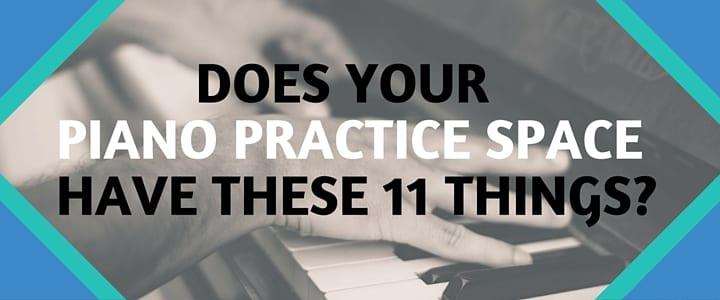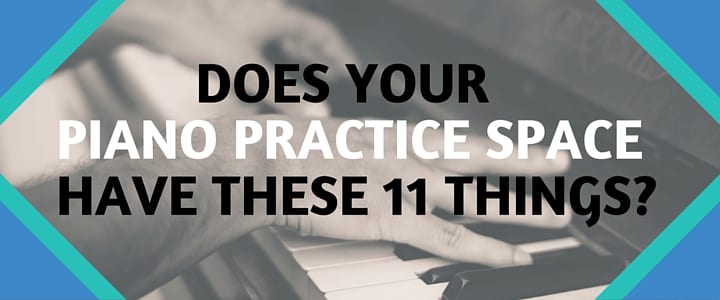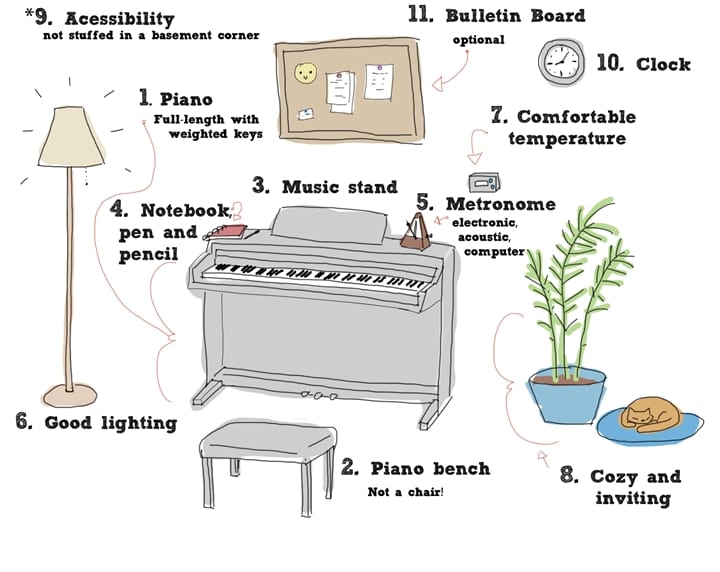Here on the TakeLessons Blog, we’ve discussed general piano practice tips, and well as how to structure and plan out your practice time. But if you don’t have your practice space set up just right, you still could be costing yourself valuable time and energy.
Fortunately, we received a sneak peak of an eBook designed to help you set up your space for success, so you can practice piano at home efficiently and comfortably. We’re excited to check out the eBook, written by Allysia over at PianoTV.net, and we wanted to share the excerpt below with you in the meantime!
Continue reading to check it out…
Practicing the piano can be a relaxing and enjoyable experience, but only if you have the right environment. A conducive practice space will help you stay focused and motivated, which in turn will help you improve faster.
Here are 11 things your piano practice space must have if you want to make the most of your practice sessions.
How Can I Practice Piano at Home?
There are many ways to practice piano at home, depending on what level you are at and what your goals are:
- For beginners, one of the best ways to learn is by using a keyboard with lighted keys. These keyboards will show you which keys to press for each note, making it easy to follow along with sheet music or tutorials.
- If you are more advanced, you may want to consider investing in a weighted keyboard, which will help you develop your finger strength and dexterity.
- You can also find a variety of apps and online programs that offer piano lessons and exercises. And of course, there is always the option of simply sitting down at the piano and experimenting.
No matter what your level, there are plenty of ways to practice piano at home and improve your skills. The most important thing is to stay consistent by practicing the piano often!
Still looking for tips on how to optimize your piano practice routine? Talk to your piano instructor to get some good tips for practicing the piano – and don’t be afraid to check out helpful instructional videos like the one you see below:
https://www.youtube.com/watch?v=2wQ1ZXph1HI
Piano Practice Room Must Haves
If I had a dollar for every time a student told me, “I didn’t practice because my piano is stuffed away in a dark, cold basement,” I wouldn’t be rich, but I’d be able to buy something really nice.
If your piano is hard to get to (like in a basement), or at the center of the action (in a living room where your five other family members are always hanging out and watching TV), it’s going to be really hard to set up a regular practice schedule. If your basement creeps you out, why would you want to go there every day to practice piano? If your family is yelling at you to be quiet, are you really going to have an enjoyable session?
Do everything you can to put your piano in a nice, quiet area that you feel comfortable in. My piano is in a sunny side room (where I teach), but if you live in a dwelling with a lot of other people, having a keyboard in your bedroom is a great idea too.
The following image outlines what I consider to be the ideal piano practice space, with all the necessary tools to succeed.
1. Piano
This is fairly obvious – you’ll have a hard time practicing without a piano or keyboard. Nothing fancy is required here, but do try to get something with weighted keys, as it helps develop your finger strength. A full-length (88 keys) keyboard isn’t necessary in the beginning, but will be after about a year, so keep that in mind.
2. Piano bench
Please, for the love of everything that is good, use a bench and not a chair. Chairs are usually too low and promote poor posture. If the chair has arms, they’ll be in the way of your own arms. Benches aren’t that expensive and you can even get adjustable ones if you’re feeling fancy.
3. Music stand
All pianos and most keyboards come with a built-in music stand, but not all do. If your keyboard doesn’t have a stand, you’ll have to get creative. You can buy a music stand (the kind you used in band) and put it behind your keyboard – I used that set-up for years.
4. Notebook + pen and pencil
I keep a notebook with all my practice goals on my piano in an organizer tray. If your piano doesn’t have the space for something like that, just make sure you keep it close at hand – you’ll be using it regularly. I like having a pen to write in my notebook, and a pencil to make marks directly on the music.
5. Metronome
If you have an electric keyboard, read through the manual – most have a metronome function. If it can emphasize certain beats (like the first beat of a measure), then great! Otherwise, being able to tap a specific tempo is all it needs to do. You can buy manual metronomes, the kind that go back and forth like a clock (I grew up with one of those), or electric ones. There are even metronome websites if you want to use your phone or tablet (be careful though, it shouldn’t be a huge pain to load up to use, or else you won’t want to use it).
6. Good lighting
If your practice room isn’t very bright, get a lamp, because the last thing you want to do is get a headache squinting at music, or worse, hurt your back hunching forward. I’m a big fan of lamps – they’re pretty and add ambiance.
7. Good temperature
Cold is bad. Cold tenses up your body and your fingers, so not only will it be harder to play, it’ll be more strenuous too. This is reason #731 not to have your piano stuffed in a basement, unless you’re one of the rare few with a warm basement. Plus, in creating an inviting space to play, most of us don’t feel ‘invited’ if we have to bundle on the layers just to practice.
8. Accessibility
Reason #732 not to put your piano in a basement. A flight of stairs might not seem like a big deal, but when you’re lounging on the couch in front of the TV, it really will. If your piano is near or a part of your living space, you’ll be a lot more likely to sit down and play. Trust me. Make it as easy as possible to get to your piano.
9. Cozy and inviting
If your space has good lighting, it’s at a good temperature, and it’s easy to get to, you’re 80% of the way there. I have a music organizer on my piano that keeps things from getting cluttered, a lamp that looks nice, a flowering plant, and an ornamental bongo just because. My piano space looks like somewhere I want to hang out and spend time.
10. Clock
Make sure there’s a clock nearby so you can keep track of your practice time. I usually set time estimates for how long I practice (10 minutes of warm-up, 15 minutes of technique, etc), so a clock is invaluable for staying organized and focused.
11. Bulletin board (and other wall accessories)
Optional but awesome. Most pianos are staring into a big blank wall – not very exciting. A bulletin board at your practice space can go a long way to make it awesome – you can put up pictures, inspirational posts, your goals, anything you want. Or you could put up a white board and write your weekly practice plans on that. Or you could put some art on the wall.
How to Find Piano Practice Rooms Near Me
(insert image)
Maybe you’re new to the piano or maybe you’ve been playing for years. Either way, you need a good practice space if you want to improve your skills and perfect your craft. But how do you find a piano practice room that suits your needs? Keep reading for our tips on how to find the perfect piano practice room near you.
1. Finding a Piano Practice Room
The first step is finding a list of potential practice rooms in your area. A quick Google search should do the trick. Once you have a list, it’s time to start narrowing it down. Consider things like price, location, amenities, and hours of operation. You should also read online reviews to get an idea of what other people have thought about each space.
2. What to Look for in a Piano Practice Room
The ideal piano practice room will be spacious, clean, quiet, and well-lit. It should also have good acoustics. Ideally, it would be climate-controlled so that the temperature and humidity are always comfortable. The space should also have a piano that is in tune and in good condition. If possible, find a space with multiple pianos so that you can try out different instruments.
3. Making the Most of Your Piano Practice Room
Once you’ve found the perfect piano practice room, it’s up to you to make the most of it! First, set some goals for yourself so that you can track your progress over time. Then, create a practice schedule and stick to it as much as possible. Make sure to warm up before you start playing and cool down afterwards so that you don’t injure yourself. And finally, take breaks when you need them! Don’t forget to hydrate and stretch while you’re taking a break from practicing.
4. Troubleshooting Common Piano Practice Room Problems
If you find yourself struggling to stay focused while practicing alone, try listening to music or podcasts with headphones while you play. If the space is too hot or cold, see if there are any adjustable settings on the thermostat or ask the staff if they can do anything about it. And finally, if the noise level is too loud for comfortable practicing, try using earplugs or noise-canceling headphones.
What is a Good Piano Practice Routine?
Many students ask how much they should practice the piano. The answer, unfortunately, is not as simple as “practice for X number of hours per day.”
The amount of time you should spend practicing depends on a number of factors, including your goals, your current skill level, and how much time you have available. Creating a good practice routine is more important than simply clocking in a certain number of hours.
Your Goals
The first step in creating a solid practice routine is to sit down and figure out what your goals are. Do you want to be able to play classical pieces? Do you want to learn jazz? Once you have a good understanding of your goals, you can start creating a plan to achieve them.
Your Skill Level
Your skill level will also dictate how you should go about structuring your practice routine. A beginner may need to spend more time practicing the basics, such as scales and arpeggios, while an advanced student may need to focus on perfecting more difficult pieces.
How Much Time You Have Available
Obviously, the amount of time you have available to devote to piano practice will also affect your routine. If you only have 30 minutes a day to practice, you’ll need to make the most of that time by focusing on specific goals and skills.
Structuring Your Practice Routine
Once you’ve considered all of the above factors, it’s time to start structuring your practice routine. A good rule of thumb is to start with the basics and work your way up. For example, if you’re just starting out, you might want to spend 10 minutes practicing scales, 10 minutes practicing chords, and 10 minutes working on a specific piece. As you become more comfortable with the material, you can increase the amount of time spent on each activity.
Is it Good to Practice Piano Every Day?
A lot of people ask me how much piano practice is enough. The simple answer is that it depends on your goals, and how quickly you want to achieve them. If you’re just starting out, or coming back after a long break, 20 minutes a day is a good place to start. But if you’re serious about making progress, you should be practicing for at least 30 minutes a day.
There are many benefits to practicing piano every day. First of all, it helps you develop good habits and prevent bad ones from forming. Practicing every day also helps you to gradually improve your skills and technique. And finally, the more you play, the more music becomes a part of who you are.
Of course, there is such a thing as too much practice. If you find yourself feeling anxious or stressed about practicing, or if you find that your playing isn’t improving despite putting in a lot of hours, then it’s time to take a step back and re-evaluate your approach. Remember that the goal of practice is to improve your skills and enjoy the process. If it starts to feel like a chore, then something is wrong.
So how much piano practice is enough? The answer is that it depends on your goals and how quickly you want to achieve them. If you’re just starting out, 20 minutes a day is a good place to start. But if you want to make rapid progress, you should be practicing for at least 30 minutes per day. And if you find yourself getting stressed about practicing, or not seeing any improvement despite putting in lots of hours, take a step back and re-evaluate your approach.
What is the Best Way to Practice Piano?
Many people who are interested in learning to play the piano wonder what the best way to practice is.
Unfortunately, there is no easy answer, as the best way to practice depends on a number of factors, including your current skill level, the amount of time you have available, and your goals for playing the piano. However, there are a few general principles that can help you make the most of your practice time.
First, it is important to set aside a regular time each day for practicing. This will help to ensure that you make steady progress and don’t become frustrated by trying to fit practice into an already full schedule.
Second, be sure to warm up your hands and fingers before beginning any challenging pieces. This will help prevent injuries and make it easier to transition into more difficult music.
Finally, focus on one thing at a time. Trying to learn too many new things at once can be overwhelming and lead to frustration.
And of course, make sure you create a piano practice space that is optimized for your unique piano practice routine. Ask your piano teacher for tips to help you set up your space!
Your practice space should be inviting. If you play piano to relax, make it a space that relaxes you. If you’re planning on spending three or four hours of your week there (or more), do what you can to make it nice.
Readers, what tips have you found effective as you practice piano at home? What other items do you keep nearby? Let us know in the comments!
Suzy S.



